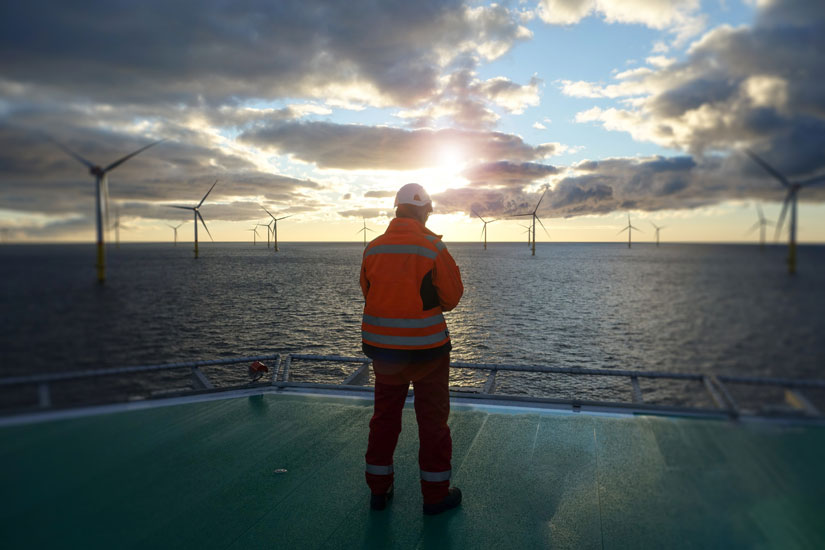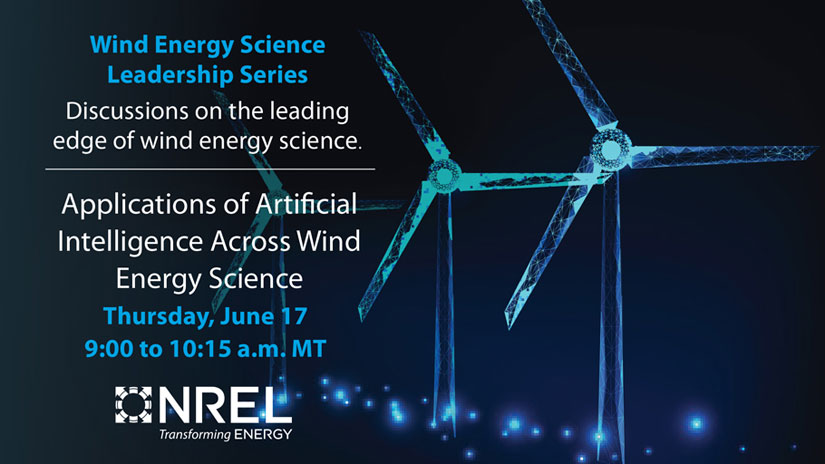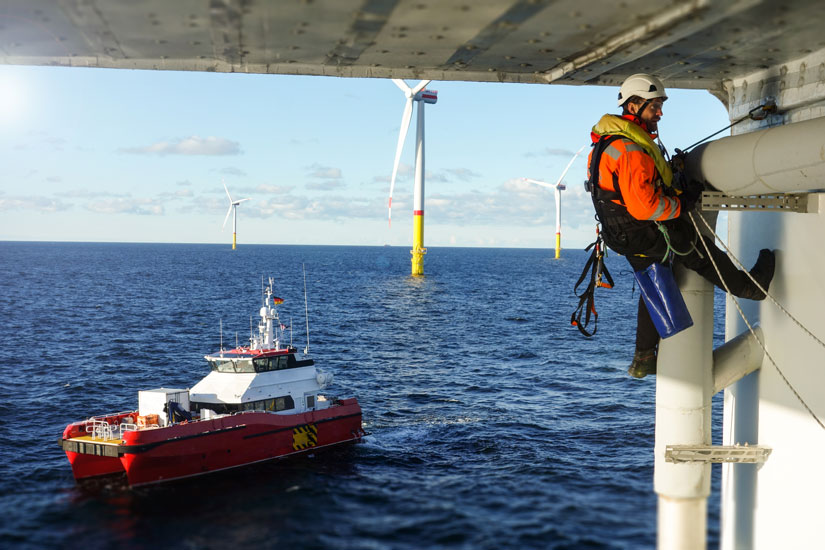The Leading Edge: June 2021 Wind Energy Newsletter
In this edition, NREL partnerships with the offshore wind industry step into the spotlight to articulate a vision for an offshore wind energy in the United States.
News Stories
Partnerships Amplify Velocity of Offshore Wind Innovation
The U.S. Department of Energy (DOE) and the White House have made offshore wind a centerpiece of plans to strengthen the nation's energy infrastructure, announcing a goal to deploy 30 gigawatts of offshore wind by 2030—a huge leap from the 42 megawatts currently in operation. Not only could this provide enough electricity to power 10 million American homes and cut carbon dioxide emissions by 78 million metric tons, but it could also support as many as 77,000 new jobs.
The success of this initiative will rely, in part, on partnerships to accelerate research and development (R&D) and establish new offshore wind energy systems in such an ambitious time frame. NREL is certain to be at the center of many of these efforts, contributing expertise in research related to offshore wind as well as building coalitions.

NREL Joins Industry in Leading Cybersecurity Threat Evaluation for the U.S. Wind Fleet
NREL and six leading industry organizations joined forces to develop a national Wind Cybersecurity Consortium. The goal of the consortium is to improve the cybersecurity of the U.S. wind fleet through collaborative analysis, development, and information sharing.
On the Radar
Biannual Newsletter Release Showcases NREL Research and Collaboration
The biannual DOE Wind R&D Newsletter provides news about recent Wind Energy Technologies Office R&D projects, accomplishments, and publications.
The Spring 2021 issue features four articles covering the work of NREL researchers and their collaborators across the globe. NREL-related news items include:
- Research shows expected wind energy cost declines of 37%–49% by 2050
- Explorations into the motivations for wind repowering
- Highlights from the Interconnections Seam Study to explore the benefits and costs of enhanced transmission across U.S. electric grid
- A game-changing inverter specifically designed for small- and medium-scale wind turbines.
An Overview of Fixed-Bottom Offshore Wind
Join the WINDExchange initiative for a webinar on Wednesday, June 16, at 11 a.m. MT for a webinar about fixed-bottom foundation offshore wind technology. Hosted by NREL offshore wind researcher Walt Musial, the presentation will cover basic technical information, including a discussion of foundation types and construction considerations.
Go to the webinar's registration page to learn more and register.
Applications of Artificial Intelligence Across Wind Energy Science
On Thursday, June 17, at 9 a.m. MT, a panel of NREL researchers—Ryan King, Dylan Harrison-Atlas, Mike Optis, and Ganesh Vijayakumar—will discuss how advances in artificial intelligence and machine learning drive further progress in wind energy science and engineering.
To learn more and register, visit the Wind Energy Science Leadership Series page.

Revision to Renewable Procurement Price Model Can Improve Comparisons Across Markets
Researchers have developed a new method to improve like-for-like comparisons for renewable energy procurement prices across varying markets. An article in Joule, Toward Global Comparability in Renewable Energy Procurement, co-written by NREL researcher Philipp Beiter and other members of NREL-led International Energy Agency Wind Task 26, describes this more holistic approach to capturing relevant project revenue and value elements. Co-author Lena Kitzing summarizes the research and its importance in a video.
Energy Policy Podcast Explores Hidden Aspects of Wind Repowering
Technical University of Denmark Associate Professor Lena Kitzing discusses some of the hidden aspects of wind repowering—the combined activity of dismantling or refurbishing existing wind turbines and commissioning new ones—in an Energy Policy Podcast. The conversation relates to a Nature Energy article, Multifaceted Drivers for Onshore Wind Energy Repowering and Their Implications for Energy Transition, which Kitzing cowrote with several members from the International Energy Agency Wind Technology Collaboration Programme—Task 26, Cost of Wind Energy—led by NREL researcher Eric Lantz. The Wind Energy Technologies Office explains more about this research.
Downwind: In Case You Missed It
National Offshore Wind Research and Development Consortium Announces Offshore Wind Supply Chain Roadmap Project
The National Offshore Wind Research and Development Consortium announced a comprehensive U.S. offshore wind supply chain project. The Supply Chain Roadmap aims to present the collective benefits of a domestic supply chain and facilitate the acceleration of the offshore wind energy industry in the United States.

Changing Winds: Emerging Wind Turbine Technologies
POWER Magazine covered the ongoing evolution of wind energy technology and the emergence of new industry developments. In addition to referencing the Grand Challenges in the Science of Wind Energy to which NREL authors were major contributors, the article discusses the development of 3D-printed wind turbine blades through a DOE project of which NREL is a part.
Publications
Evaluation of the Potential for Wake Steering for U.S. Land-Based Wind Power Plants
In Evaluation of the Potential for Wake Steering for U.S. Land-Based Wind Power Plants, authors evaluate the potential of wake steering to increase power production for U.S. land-based wind power plants. Using NREL's FLORIS tool to model wake steering, researchers evaluate a subset of 60 existing wind plants and, assuming a constant turbulence intensity of 8%, they find wake steering could yield an average annual energy production gain of 0.80%, equivalent to recovering 13.85% of baseline wake losses. In addition, the researchers find that these efficiency gains increase for wind power plants with higher wake losses.
Autonomous Sensor System for Wind Turbine Blade Collision Detection
Autonomous Sensor System for Wind Turbine Blade Collision Detection authors present an automated blade collision detection system for use on wind turbines designed to support, monitor, and obtain quantitative assessments of wind energy impacts on wildlife. Comprising a wireless, multisensor module mounted at the root of a wind turbine blade, the collision detection system measures surface vibrations that, when triggered, activate a blade-mounted camera that captures an image of the colliding objects. Sensor data recorded during field testing of the system on an operational wind turbine at NREL's Flatirons Campus is used to augment the automated detection algorithms for collision detection using machine-learning approaches.
On the Scaling of Wind Turbine Rotors
On the Scaling of Wind Turbine Rotors formulates laws for scaling wind turbine rotors and designs three subscale rotors of a 10-megawatt reference wind turbine for validation inside a wind tunnel and in the field. One of the three models is designed for the SWiFT facility in Lubbock, Texas, which is operated by Sandia National Laboratories. The study considers both the steady-state and transient response cases, including the effects of aerodynamic, elastic, inertial, and gravitational forces. The results show that even models characterized by very significant scaling factors can accurately match several key performance indicators. Additionally, when an exact match is not possible, relevant trends can at least be captured.
The Curled Wake Model: A Three-Dimensional and Extremely Fast Steady-State Wake Solver for Wind Plant Flows
The Curled Wake Model: A Three-Dimensional and Extremely Fast Steady-State Wake Solver for Wind Plant Flows authors propose a new hybrid method, the curled wake model, that uses analytical solutions with an approximate form of the Reynolds-averaged Navier-Stokes equations to solve the time-averaged flow over a wind power plant. Researchers perform simulations of wind flow over the Columbia River Gorge to demonstrate how the curled wake model functions in complex terrain and find that the new solver reduces the time and related cost it takes to simulate a steady-state wind plant flow.
Share

